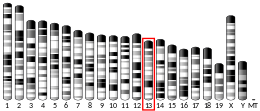CXCL14
protéine humaine
Le CXCL14 (ou BRAK) est une chimiokine dont le gène est situé sur le chromosome 5 humain.
Rôles
modifierIl a un rôle variable sur les cancers. Ainsi, dans le cancer de la prostate, il joue le rôle d'un gène suppresseur de tumeur[5], de même dans les cancers ORL[6]. Au contraire, il facilite la prolifération des cancers du sein[7], de la thyroïde[8], du pancréas[9] ou du côlon[10]. Dans l'ostéosarcome, son expression est stimulée par l'IRX1 facilitant la formation de métastases[11].
Notes et références
modifier- GRCh38: Ensembl release 89: ENSG00000145824 - Ensembl, May 2017
- GRCm38: Ensembl release 89: ENSMUSG00000021508 - Ensembl, May 2017
- « Publications PubMed pour l'Homme », sur National Center for Biotechnology Information, U.S. National Library of Medicine
- « Publications PubMed pour la Souris », sur National Center for Biotechnology Information, U.S. National Library of Medicine
- Schwarze SR, Luo J, Isaacs WB, Jarrard DF, Modulation of CXCL14 (BRAK) expression in prostate cancer, Prostate, 2005;64:67–74
- Ozawa S, Kato Y, Komori R, Maehata Y, Kubota E, Hata R, BRAK/CXCL14 expression suppresses tumor growth in vivo in human oral carcinoma cells, Biochem Biophys Res Commun, 2006;348:406–412
- Allinen M1, Beroukhim R, Cai L et al. Molecular characterization of the tumor microenvironment in breast cancer, Cancer Cell, 2004;6:17–32
- Oler G, Camacho CP, Hojaij FC, Michaluart P, Riggins GJ, Cerutti JM, Gene expression profiling of papillary thyroid carcinoma identifies transcripts correlated with BRAF mutational status and lymph node metastasis, Clin Cancer Res, 2008;14:4735–4742
- Wente MN1, Mayer C, Gaida MM et al. CXCL14 expression and potential function in pancreatic cancer, Cancer Lett, 2008;259:209–217
- Zeng J1, Yang X, Cheng L et al. Chemokine CXCL14 is associated with prognosis in patients with colorectal carcinoma after curative resection, J Transl Med, 2013;11:6
- Lu J, Song G, Tang Q et al. IRX1 hypomethylation promotes osteosarcoma metastasis via induction of CXCL14/NF-κB signaling, J Clin Invest, 2015;125:1839-56




